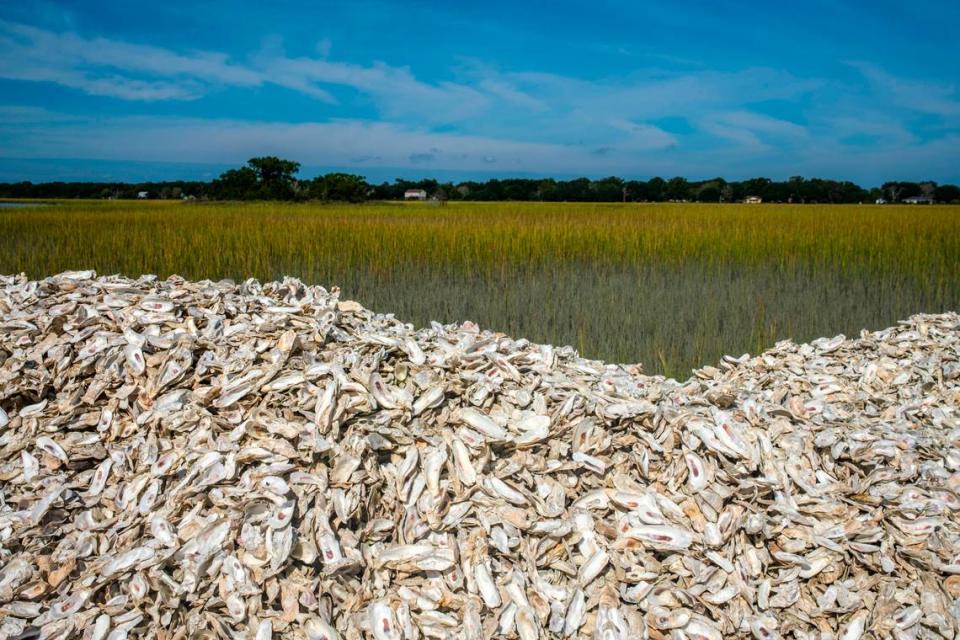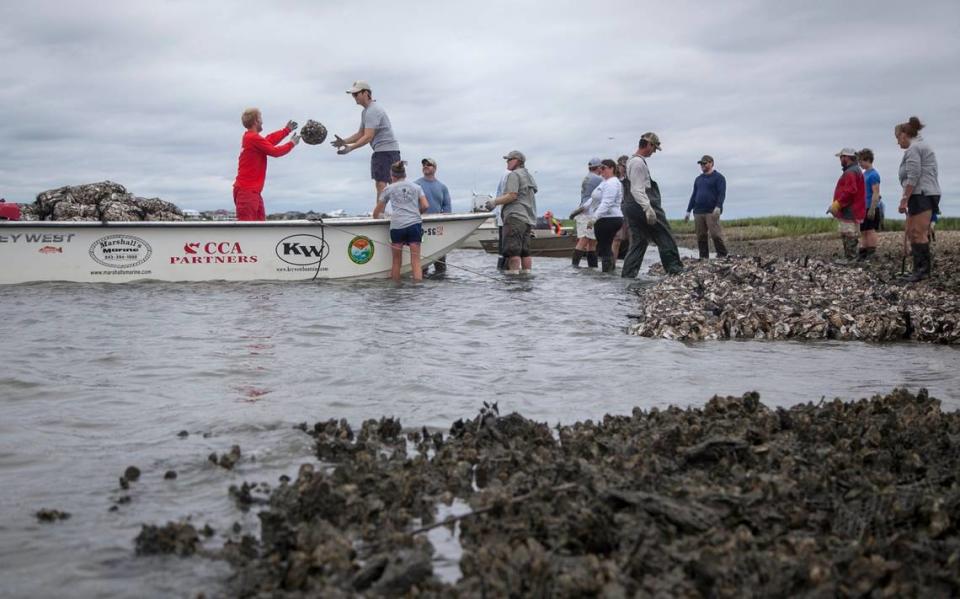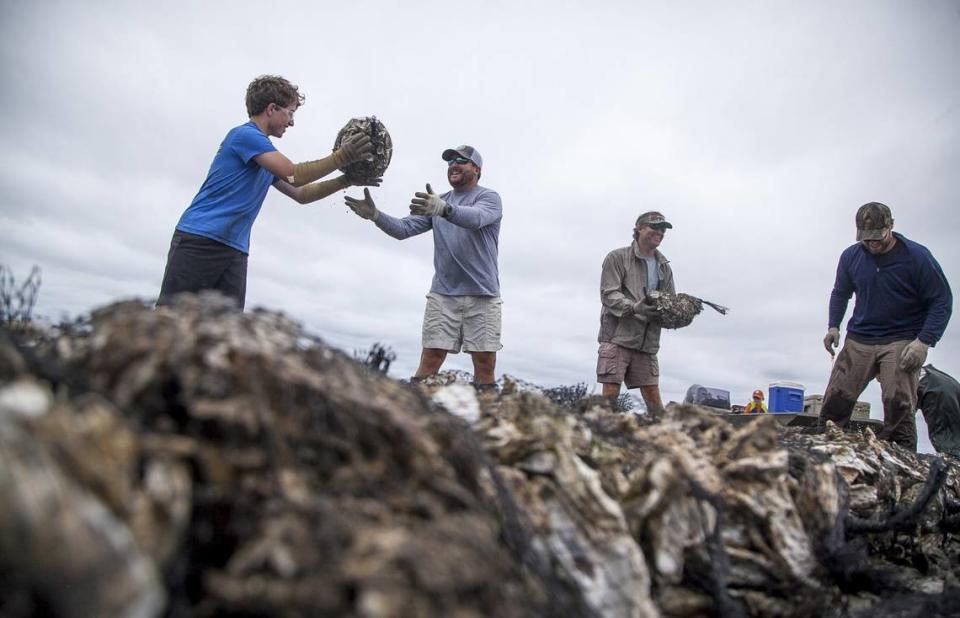Oyster shells sell for top dollar as biologists scramble to protect shellfish beds
Sitting atop the crow’s nest of a small barge, the boat captain shielded his eyes from the July sun and pitched his gaze to the commotion below.
The hum of heavy equipment and the clatter of oyster shells broke the morning’s silence as work crews piled thousands of pounds of dried shells on the deck, eventually creating a mound 12 feet high.
When the last shell had been placed on the pile, the captain maneuvered the barge away from Russ Point Landing and down a tidal creek near Fripp Island on a mission to save wild oysters.
The state-sponsored work was part of an effort to protect imperiled oyster populations by returning shells from restaurants, backyard oyster roasts and other sources to tidelands. Putting shells back in the mud rebuilds reefs, the refuges baby oysters need to grow and multiply.
But efforts to restore oyster reefs in places like Beaufort County face a threat that could affect virtually anyone who depends on the harvest of wild oysters.
South Carolina and nearby states are having trouble finding the shells they need to put back in tidal areas to restore oyster populations.
At one time considered marine trash, oyster shells have become a valuable — but limited — commodity along the South Atlantic coast.
“This definitely is a multi-state, national problem: finding shell,’’ said Ben Dyar, an oyster specialist with the S.C. Department of Natural Resources.
Without adequate supplies of shells, oyster populations could suffer, curtailing the commercial harvest and driving up the price of shellfish in restaurants. Fewer oyster reefs and lower populations could also mean more polluted waterways because oysters filter out contaminants in water.
There are multiple reasons for the shell shortage, including the toll that over-harvesting has taken through the years in South Atlantic states. But people also are throwing away the shells after serving oysters in seafood houses or at community oyster roasts. People are using shells to pave driveways and enhance gardens. And they’re crushing shells to sell for chicken feed or as ingredients in cosmetic products.
The shortage is so pronounced that some states have spent millions of dollars through the years purchasing shells to restore and rebuild oyster reefs — sometimes competing for the limited shells offered by shucking houses from Texas to Virginia.
Prices have increased from well under a dollar a bushel two decades ago to many times more than that today. The cost is now running from $3 to $7 a bushel, say some shucking house owners and state wildlife officials.
South Carolina, with vast marshes and hundreds of seafood restaurants, spends, on average, about $100,000 annually buying shells from other states, according to the S.C. Department of Natural Resources.
All told, the state, using a variety of funding sources, has spent nearly $1 million since 2012 acquiring more than 407,000 bushels of oyster shells, which equates to about 22 million pounds, according to the DNR.
South Carolina had been paying less than $3 a bushel, but the average price has jumped above $3 in the past two years, the DNR says.
Competitive market
Plenty of other states also are hungry for oyster shells.
Georgia spends about $138,000 annually buying shells and trucking them to the Peach State. Shells often come from Florida and sometimes Texas.
Some of the biggest expenditures on the South Atlantic coast are around the Chesapeake Bay in Maryland and Virginia.
Virginia spends $2 million to $3 million annually purchasing oyster shells from instate shucking houses and other sources in the state, state officials there said.
Maryland has even bought railroad cars of fossilized oyster shells from Florida to help with its oyster restoration programs in the Chesapeake Bay, where oyster populations have plummeted from historic levels.
“The whole thing is crazy,’’ said Ted Wilgis, an oyster reef specialist with the non-profit N.C. Coastal Federation. “It just became a bidding war.’’
Some states, including South Carolina, have been more successful recently at buying shells than North Carolina because the Tar Heel State has a limit on how much it can spend. In Georgia, officials say it isn’t always easy to find oysters when they want to buy them.
“Oyster shell has become a precious commodity, with demand far outstripping the supply,’’ said Cameron Brinton, a marine biologist with Georgia’s Coastal Resources Division.
Oysters, which grow in most coastal areas of the United States, have a life cycle that depends on the tides and how successful larval oysters are at finding hard surfaces.
Baby oysters, little more than indistinct goo after spawning, float on the tide and stick to hard surfaces, ranging from existing oyster reefs to dock pilings or bridge supports. In South Carolina, this process occurs during the spring and summer.
Once attached, they nestle into cracks and crevices, where they form their own shells and grow up.
But the best hard surfaces for baby oysters to stick to are existing oyster reefs, experts say.
‘Shells are the profit’
Jeff Milliken’s family has run oyster shucking businesses for more than 60 years in the coastal crossroads of Shallotte, North Carolina, selling canned oysters to grocery stores and restaurants.
Oyster sales always kept his family business afloat, providing a decent living for the Millikens.
But for years, oyster shells left over from the shucking process were little more than waste material. Piles of oyster shells at the shucking house were virtually given away.
That began to change in the 1980s, as people increasingly sought to buy the shells, Milliken said. And that has enriched his family business.
The company sometimes sells what it calls scoops of oyster shells, the amount that can be held in the bucket of a front-end loader, for about $500. In the 1980s, the charge was closer to $50, he said.
“My dad always made the point that the oysters pay the bills and the shells are the profit,’’ Milliken, 60, said. “The shells have become very lucrative.’’
The S.C. Department of Natural Resources buys large amounts of Milliken’s shells to restore oyster beds.
“South Carolina has pretty much bought all of our production for reseeding the beds in South Carolina,’’ Milliken said. “We do sell to the public but not like we used to. A lot of it is held for the state of South Carolina.’’
In addition to buying shells from people like Milliken, states are trying to re-use oyster shells, rather than letting them be dumped in landfills and in the woods, or crushed and used to pave driveways.

Commercial harvesters who lease oyster grounds from state agencies for private use often must put back a substantial percentage of oyster shells after they pluck shellfish from the mud.
Some states have launched oyster shell recycling programs that encourage restaurant owners to hold the shells until state natural resources officials or environmental groups can pick them up and replant them on public oyster grounds in the wild — as the South Carolina DNR did this summer near Fripp Island in Beaufort County.
State agencies and environmental groups from Maryland to Georgia have established shell drop-off sites on the coast for people who haul whole oysters home for backyard and community oyster roasts. State officials and volunteers then pick up shells at these drop-off sites and return them to marshes and sounds.
Additionally, some states have begun to allow oyster farming that could offset losses from wild populations.
Meanwhile, in North Carolina, Virginia and Maryland, resource managers are working to establish artificial reefs to offset the shortage of oyster shells and replenish wild shellfish populations near the Outer Banks and in the Chesapeake Bay.
For those reasons, oysters aren’t likely to disappear from the landscape as a result of the shell shortage, many natural resources officials say. But losing wild oyster reefs could deplete the populations, they say. Even with some success from artificial oyster reefs, returning shells to the wild is generally considered the best way to replenish and enhance natural reefs, some experts say.
Some restaurant owners say it’s vital to recycle oyster shells.
“If oysters are harvested but none of the shells are recycled,’’ Hilton Head Island restaurateur and chef Chris Carge said, “the oyster seeds are just going to drift away” and eventually, the local oyster population will dwindle significantly.
Should oyster populations drop because there aren’t enough shells to restore wild populations, it could diminish local fishing economies, drive up oyster prices for restaurants, hurt water quality and affect other marine species that thrive around oyster reefs, state officials say.
In South Carolina, for instance, more than 100 species of marine animals rely on oyster reefs for survival. These mounds of shells, which are submerged below the water at high tide, provide habitat for small bait fish, which then attract larger, popular sports fish, including red drum, sea trout and flounder, according to the state Department of Natural Resources.
Commercially caught oysters generate a dock value, or wholesale value, of some $3 million annually in South Carolina, making oysters the state’s fourth-largest fishery, the DNR said in a report last winter.
Without an adequate supply of shells to replenish populations, oyster harvesting seasons might need to be shortened, a change sure to upset commercial and recreational fishermen.
“At some point, it is very plausible that there would have to be other measures and other tools taken to help manage that resource, meaning closing areas down for harvest for longer periods of time,’’ Dyar said, noting it could have a corresponding effect on oyster prices.
Maintaining healthy oyster populations also is important because they filter out pollution in water, keeping tidal creeks cleaner.
Chicken feed and makeup
Perhaps the biggest reason for the lack of shells is historic over-harvesting in some areas, as well as the decline of shucking houses in others.
The Nature Conservancy found that 85% of the world’s oyster reefs have been lost since the late 1800s because of over-harvesting, pollution and other factors, according to a S.C. Sea Grant Consortium report.
Places like South Carolina also no longer have canneries where large supplies of oyster shells could be found to return to the salt marshes for restoration. At one point the state had 16 canneries, but the last one closed in 1986, according to the state DNR.
Some years, it is harder to find shells than in other years, depending on how many oysters are harvested. Beyond that, the lack of oyster shells may result, in part, from the public’s increasing appetite for buying oysters in the shell, rather than in cans, and demand by a variety of businesses.

Poultry farms, construction companies and cosmetics manufacturers are among businesses that use oyster shells in their products. The calcium in oyster shells is believed to enhance many products, prompting efforts to find shells and grind them up.
Some poultry farmers purchase chicken feed supplements made from oyster shells. When fed to chickens, crushed oyster shells are believed to make egg shells harder.
Lesa Vold, a spokeswoman for the Egg Industry Center, said egg farmers like shell-based feed, but also are using other sources of calcium in places where shells are hard to find. The center supports egg producers across the country.
Milliken said his company for years sold crushed oyster shells to farm supply stores for sale to chicken farmers.
“We crushed just a huge amount of them,’’ he said. “It’s the best calcium for chicken egg-laying there is.’’
One marketing study, released this summer, said the oyster shell calcium market is expected to grow by 5% by 2030, fueled by an array of industrial demands for shells. Calcium carbonate in oyster shells is highly sought after, the study said.
The study, cited on the website Researchandmarkets.com, says oyster shell powder is useful in some skin-care products.
Worldwide, some manufacturers harvest oyster shells, crush them and blend them into facial cleansing powder, soaps and shampoo, according to a June 8 story on the website Premiumbeautynews.com.
Backyard oyster roasts
Another issue has arisen that has depleted the amount of oyster shells available to replenish wild populations.
Many shells are being scattered across the countryside, rather than returned to the salty tidelands of the southern Atlantic coast, after restaurants serve them or neighbors hold backyard oyster roasts.
Oysters harvested from the black pluff mud of Charleston may wind up sold to seafood markets whose customers are from Columbia, Greenville, Florence or Rock Hill. Those shells often are discarded in landfills or other places miles away from the coast.
“Quantities spread throughout the state (make) it a lot more difficult to capture that shell and bring it back to the coast,’’ Dyar said in a report to the DNR board earlier this year.
It’s difficult to say how many oysters have been removed from bays and creeks across the southeast and hauled inland, but natural resource managers say it’s a problem, despite their best efforts.
South Carolina has one of the region’s most robust shell recycling programs, with 30 sites where people can drop off shells after they’ve eaten oysters. Most of the sites are along the coast, although the DNR has them in Columbia and Greenville, as well. Once the shells are picked up, they are kept at multiple locations for months to dry out, which kills bacteria inside the shells.
But the state only captures about 12% of the shells that are harvested annually, meaning 88% of the shells from oysters sold in South Carolina are not recycled, according to a report by the S.C Department of Natural Resources.
Jean Fruh, executive director of The Outside Foundation, said the smell of keeping the oysters for typical once-a-week pickup, the cost, and additional training scare away some restaurant owners. However, the cost, Fruh and participating restaurateurs will tell you, is nominal: about $150 a month.
She said it’s worth it.
“If you don’t have oysters, you don’t have fish, shrimp and crab,” she said, because oysters create a critical habitat for the three during their juvenile period.
About 65 South Carolina restaurants collect shells for recycling, most of them in the Charleston area. Only a handful are in the Hilton Head Island and Myrtle Beach areas, according to the DNR.
Despite the struggle, natural resource managers in multiple states say they’re still trying to maintain habitat for oysters, either through the use of artificial reefs, tighter laws on shell disposal, or recycling.
Dyar, the state DNR oyster specialist, said South Carolina’s recycling program offers the best hope of maintaining enough oyster shells to replant in the marshes.
“We have seen over the last several years that sources are starting to become more scarce and the shells are becoming more expensive, causing an even more critical need for us to increase shell recycling within the state,’’ Dyar said.
Oysters needed
During the July oyster planting trip, Michael Hodges, an oyster restoration biologist with the state DNR, directed the operation in the summer heat.
Hodges and his work partner, Kevin Swain, pushed the pile of oysters onto the barge with a front end loader. After the barge hauled its cargo to the destination point, a man aboard the barge fired a water cannon at the mound of shells, scattering them into the salt marsh at high tide.
It took only 20 minutes to lay the shells in about seven feet of water along a salt marsh bank. When the tide went out, the fruits of everyone’s labor were obvious — a 390-yard line of human-planted oyster shells. It is expected to take about two years for a full row of mature oysters to develop.
Over the summer, the DNR set out to plant 10,000 bushels – or 550,000 pounds – of oyster shells in Beaufort waters, another 5,000 in Georgetown and 27,000 in Charleston.
Hodges said the program works — if the state has enough shells.
Without them, “we would see a decrease in the health of the oysters but also the health of the estuary, since they’re so tied to habitat, water quality and all the ecosystem services that they provide,’’ Hodges said.


